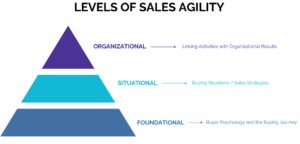The Secret Behind the Highest Performing Sales Teams: The Three Levels of Sales Agility

What started as a research journey into high-performing sales teams led us to a surprising discovery. We reviewed the data we’d gathered on over 10,000 sellers and more than 1,600 sales managers, and what we found is that Sales Agility is a cornerstone characteristic of organizations that consistently hit their growth targets.
So how did we find out about Sales Agility? Over time we started to see common themes in our research findings. We did a series of studies that were published in our books Cracking the Sales Management Code and Crushing Quota on sales metrics, sales coaching, and sales management practices.
We found sales organizations that operated at a high level were able to read situations, be ready with a plan for any situation they faced, and then successfully execute that plan, all while monitoring and assessing what’s working and what’s not.
In other words, they were Agile!
Then as we dug deeper, we identified three levels of Sales Agility. They are:
- Foundational
- Situational
- Organizational
Each level of Sales Agility has been found to consistently have huge impacts on key sales metrics like average selling price, quota attainment, and revenue per seller.

Let’s take a quick look at each level.
Foundational Agility
As indicated by its name, Foundational Agility is the solid base of the Sales Agility framework. It’s about instilling sales teams and managers with the skills to identify buyer needs, buyer motivators, and understand the psychology at play within the buying journey.
Do your sales teams know how to locate where your buyers are on their buyer’s journey, or how to develop specific plans to support the buyer and move them past their current stage? Salespeople must have the fundamental selling skills necessary to have rich, consultative dialog with their buyers. To succeed, sellers must know how to determine buyer objectives at each stage of the buyer’s journey and align their sales approach accordingly. This means that they are equipped to plan and execute sales calls appropriate to each stage of the buying journey.
These are fundamental questions for sales managers to ask because they’re necessary to move to the next level of Sales Agility.
Situational Agility
Situational Agility involves specific buying scenarios and the sales strategies that work best for each scenario along the buyer’s journey. The premise underlying Situational Agility is that different buying teams have different buying journeys. A variety of buying factors coalesce in a way that defines a unique buying situation. And each seller faces between four and six unique buying situations.
With Situational Agility sellers assess and make sense of the buying situation, choose the most effective strategy, or pattern of selling behavior, most likely to lead to a win in the buying situation they face. Top-performing sellers exhibit four primary patterns of selling rather than one.
Top sellers utilize consultative, disruptive, financial, and competitive strategies, picking the best one for the situation at hand. Sellers then execute the tactics within that strategy, constantly monitoring buyer reactions and getting feedback. Then they reassess and adjust as needed. This situational agility leads to much greater buyer alignment and increases win rates.
Organizational Agility
Organizations that have frameworks around linking activities with KPIs and organizational results are much more agile because they can shift gears much more effectively, and shift activities to align with changing results and changing conditions.
In addition, sales managers and coaches that consistently coach to activities that are aligned with their organization’s KPIs are much more effective than those who use other coaching methods.
So What Now?
You’re probably wondering why would you want to go through the hassle of attaining these different levels of agility?
If that’s you, then stay tuned for part two of our Sales Agility series to learn how Foundational Agility can help you increase your Average Selling Price by 30%.
Our Offerings
The Sales Management Code™ equips sales managers with a simple, yet powerful framework for aligning seller and manager efforts to desired business results, coaching in ways that drive maximum impact, and assessing leading indicators of progress to determine if sellers are on the right path to quota.
The Pipeline Coaching Code™ equips sales managers and leaders with a powerful framework for assessing the health of the pipeline, considering size, contents, and progress. It then equips managers to make deliberate decisions about how to ensure the health of the pipeline and the viability of deals within the pipeline. Managers will reorient effort toward the early stages of deals to improve deal viability and velocity.
VantagePoint Performance is now part of Imparta, a global leader in performance improvement for customer-facing teams.